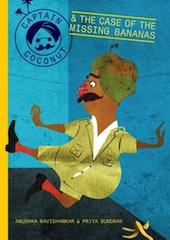
Anushka Ravishankar’s dashing detective, Captain Coconut, makes his debut in a graphic novel with the cracking (excuse the pun) of ‘The Case of the Missing Bananas’. At first glance the genre and medium of a ‘graphic novel for kids’ seem to be a misnomer. After all, graphic novels are supposed to be visual representations of serious novels or subjects as opposed to comics whose sole aim is to entertain its reader. So what makes a book a graphic novel? Anushka Ravishankar’s Captain Coconut is certainly not serious; its protagonist, detective Captain Coconut, is tongue-in-cheek-ily described as a brilliant, especially when seen through his own eyes. He is, at times, so overcome by his own brilliance that he breaks into Bollywood type item number songs in the midst of his frequent epiphanies. Called upon by Mrs. Y, his client and one-member-fan-club, to solve the mystery of the missing bananas, Captain Coconut displays his propensity to make deductions that sometimes make sense but more often than not - don’t! Mrs. Y, who greets his deductions with rhapsodies of praise and hangs on his every word, hopes and prays that the ace detective will solve the baffling case.
Since this book is a graphic novel, the illustrations maketh the book as much as the story. The illustrations by Priya Sundram are brilliant – the attention to detail in the visual characterization, careful layout and use of multiple formats make for thought provoking art. Priya Sundram makes kitsch cool – notice Captain Coconut’s nose and some of the furniture; these are cut-outs from typically printed gift wrapping paper used by traditional Indian departmental stores, the equivalents of the single screen theater. Use of paper to texture drawings, black & white and colour photo cutouts from magazines, and the use of perspective and drawings could have resulted in a bizarre visual mish mash. Instead, the eclectic elements comes together to make proudly ‘Hinglish’ pop-art compositions that are visually so interesting that it makes one pause in the midst of the story.
As the blurb on Tara Book’s website says, ‘children of different ages will ‘get’ the book in different ways’. True. I can imagine reading this to chortling laugher to a 6 year old while this book would also appeal to the sensibilities of an older (lets say, 10 year plus) age group, who would be better able to appreciate the nuances of illustration and story. The book, especially its art and dry humour, lends itself to renewed analysis and appreciation on its re-reading by older readers.
So that brings us to the question we started with – is Captain Coconut a graphic novel? The answer is a ‘Yes’, methinks. The ironic tone of the story, its pop art illustrations, multiple layout formats and its hilarious nonsensical songs are what places this book firmly in the ‘Graphic Novel’ category.
‘Captain Coconut and the Case of the Missing Bananas’ is a celebration of the medium of the graphic novel- Njoy! Thank you Anushka Ravishankar for yet another hilarious and novel graphic-novel for children.